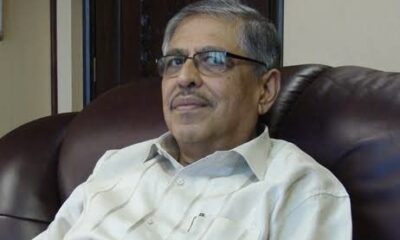World
S. Korea Says N.Korea Staged The ‘Biggest Missile’ Launch To Recover From A Previous Failed Test

(Reuters) – South Korea’s military has said North Korea’s largest missile test yet used an older, smaller intercontinental ballistic missile, and not the massive new Hwasong-17 ICBM, in part to try to head off negative domestic reaction to a failed launch.
South Korean and U.S. officials have concluded that the March 24 launch appears to have been a Hwasong-15 ICBM, a defence ministry official said, speaking on condition of anonymity because of the sensitivity of the matter.
Washington has not yet publicly weighed in, with Pentagon spokesman John Kirby telling reporters on Tuesday that the test was still being analysed.
North Korea fist test-fired the Hwasong-15 in Nov. 2017, before imposing a moratorium on ICBM testing that ended with last week’s launch.
Open-source analysts noted discrepancies in video and photos released by North Korean state media after that launch, saying shadows, weather, and other factors suggested it was from an earlier test, possibly a failed launch on March 16.
“The choice of the Hwasong-15, which is more reliable with the successful test in 2017, could be intended to block rumours and ensure regime stability by delivering a message of success within the shortest time possible, after residents of Pyongyang witnessed the failure of the March 16 liftoff,” the defence ministry said in a report provided to parliament and obtained by Reuters.
The test could additionally have been aimed at boosting its status as a military powerhouse and improving bargaining power against South Korea, the United States and the international community, the report concluded.
U.S. and South Korean officials had said that tests on Feb. 27 and March 5 involved the Hwasong-17 system, likely in preparation for a full-range launch. North Korea never acknowledged the March 16 launch or its reported failure.
Debris from that failed test rained down over Pyongyang, Ha Tae-keung, a South Korean lawmaker briefed by the military told reporters on Tuesday.
That failure prompted North Korea to tell a “big lie” and say the March 24 Hwasong-15 launch was a Hwasong-17 to avoid negative domestic public opinion, Ha said.
Thursday’s missile flew for 67.5 minutes to a range of 1,090 km (681 miles) and a maximum altitude of 6,248.5 km (3,905 miles) state media reported. Those numbers are similar to data reported by Japan and South Korea and are further and longer than the first Hwasong-15 test, which flew for 53 minutes to an altitude of about 4,475 km and range of 950 km.
Thursday’s missile’s characteristics, such as ascending acceleration, combustion, and stage separation times were similar to those of Hwasong-15 even thought the flight flew farther and reached higher altitudes, the report said.
South Korean officials had suggested North Korea may have modified a Hwasong-15 or launched it without a significant test payload to increase its range.
Analysts say the March 16 explosion may have been caused by a problem in the engines. The ministry report noted that the Hwasong-17 requires a more sophisticated cluster of four Paektusan-class engines compared with the Hwasong-15’s two, and that eight days between launches was not enough to analyse the cause of the failure.
“If March 16 was a Hwasong-17 failure and March 24 was a Hwasong-15, it obviously shows the Hwasong-17 still has teething problems,” said Vann Van Diepen, a former U.S. government official involved in weapons of mass destruction and nonproliferation.
A second successful test of the Hwasong-15 would have confirmed its reliability, but if its improved performance was only because of reduced payload, then the significance would be limited, he said.
Kenya Insights allows guest blogging, if you want to be published on Kenya’s most authoritative and accurate blog, have an expose, news TIPS, story angles, human interest stories, drop us an email on [email protected] or via Telegram
-

 Business1 week ago
Business1 week ago‘They’re Criminals,’ Popular Radio Presenter Rapcha The Sayantist Accuses Electric Bike Firm Spiro of Fraudulent Practices
-

 Business1 week ago
Business1 week agoIt’s a Carbon Trading Firm: What Kenyans Need to Know About Spiro’s Business Model Amid Damning Allegations of Predatory Lending
-

 Business6 days ago
Business6 days agoManager Flees Safaricom-Linked Sacco As Fears Of Investors Losing Savings Becomes Imminent
-

 News1 week ago
News1 week agoWoman Accused in High Defamation Blames AI As Case Exposes How Mombasa Billionaire Mohamed Jaffer Allegedly Sponsored Smear Campaign Linking Joho’s Family To Drug Trafficking
-

 Investigations1 week ago
Investigations1 week agoDisgraced Kuscco Boss Arnold Munene Moves To Gag Media After Expose Linking Him To Alleged Sh1.7 Billion Fraud
-

 Africa1 week ago
Africa1 week agoDisgraced Oil Trader Idris Taha Sneaks Into Juba as Empire Crumbles
-

 Investigations1 week ago
Investigations1 week agoFraud: How Sh235 Million Donor Cash For Nyamira Residents Was Embezzled Through Equity Bank Under Governor Nyaribo’s Watch
-

 Sports2 weeks ago
Sports2 weeks ago1Win Games 2025: Ultimate Overview of Popular Casino, Sports & Live Games










